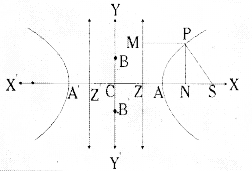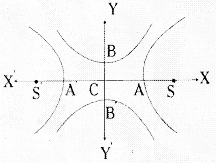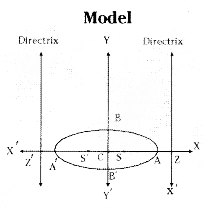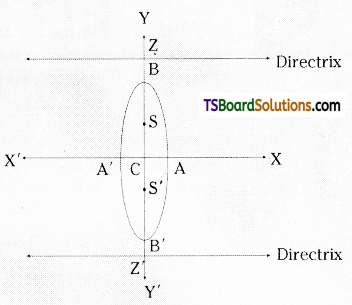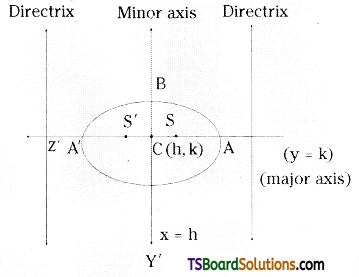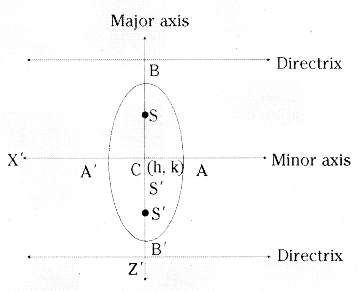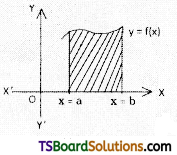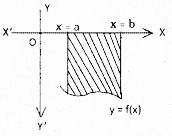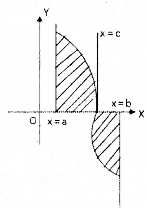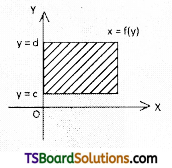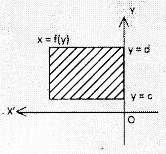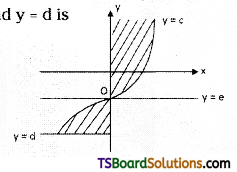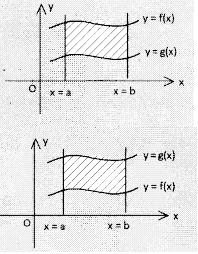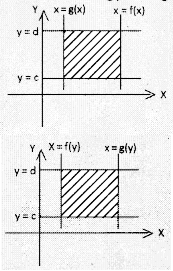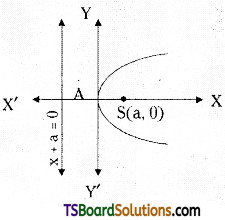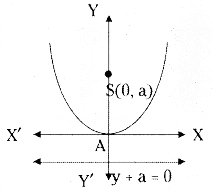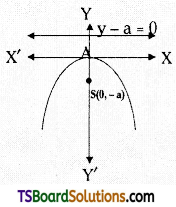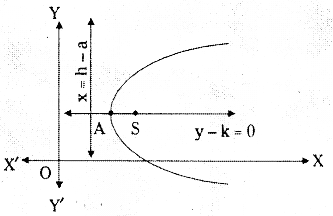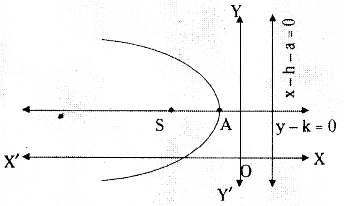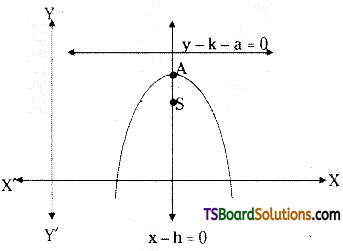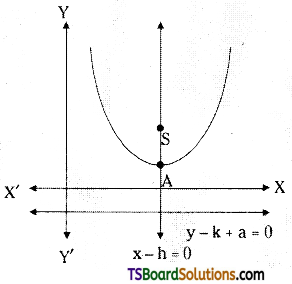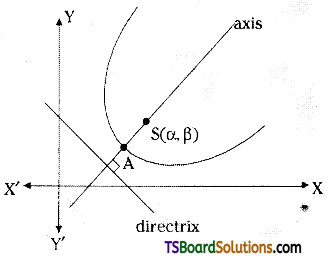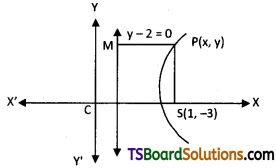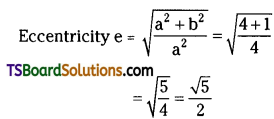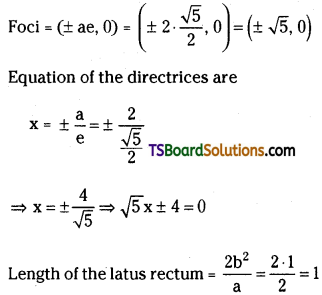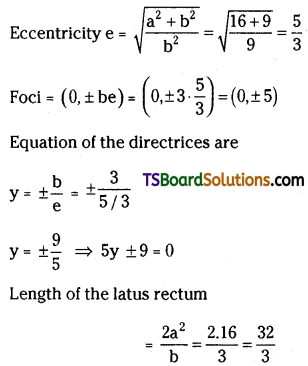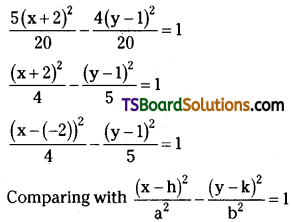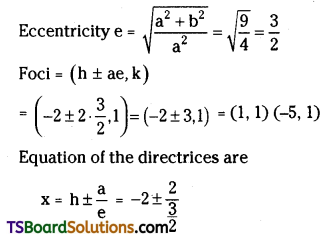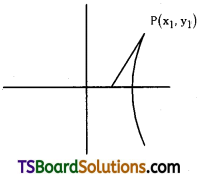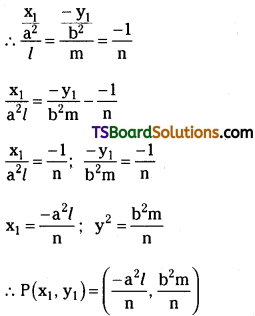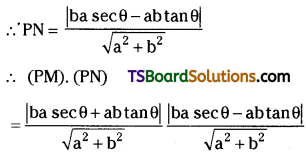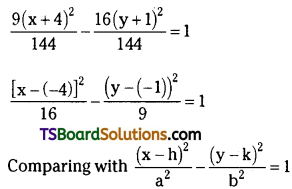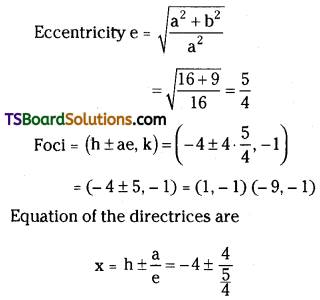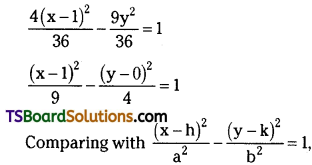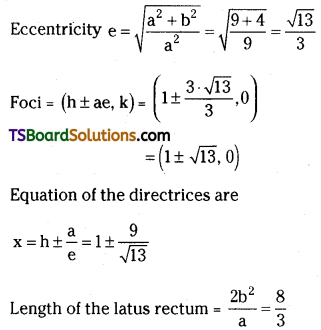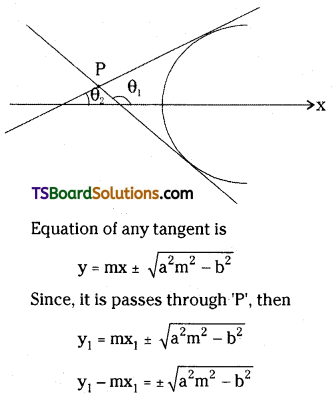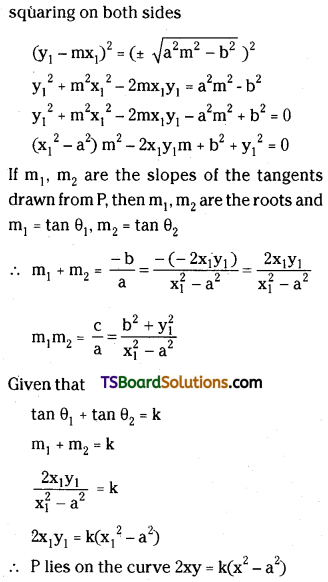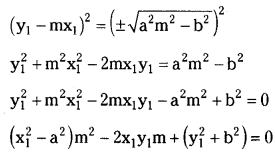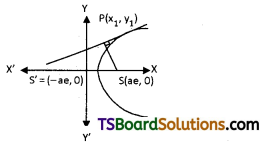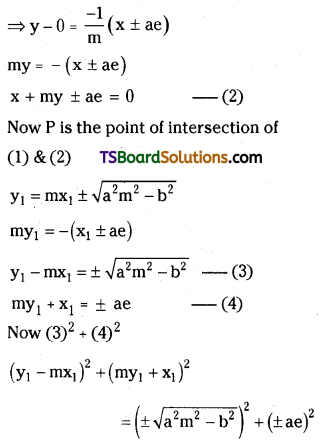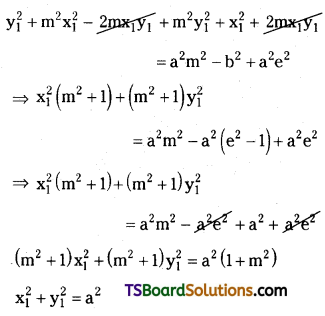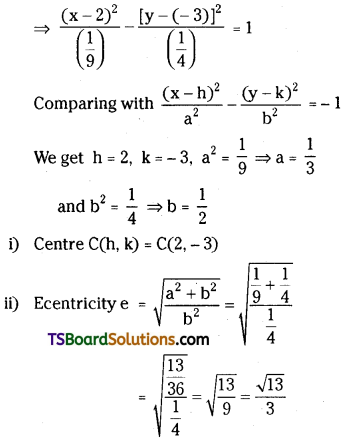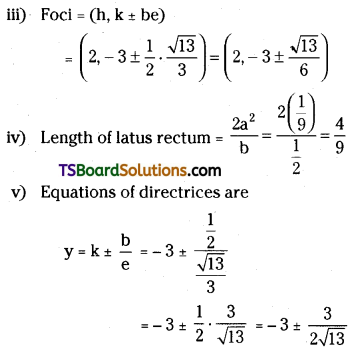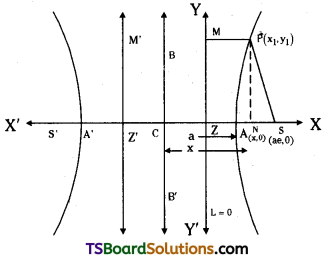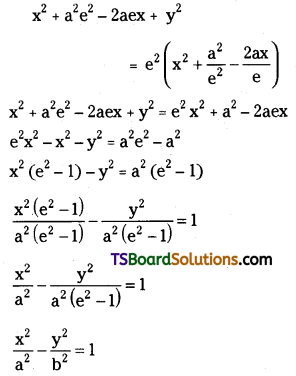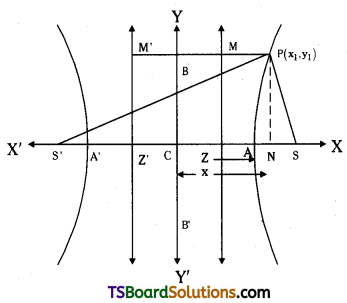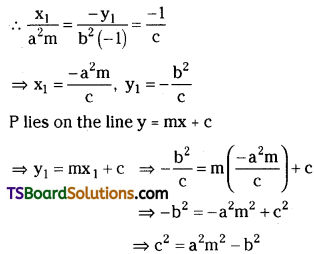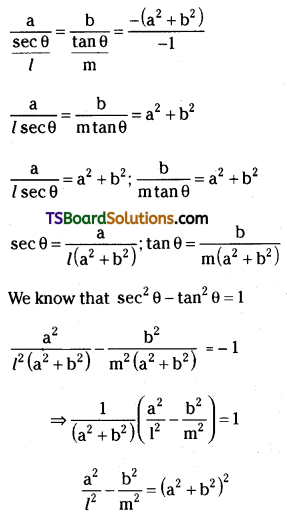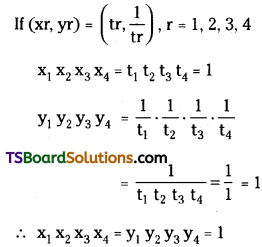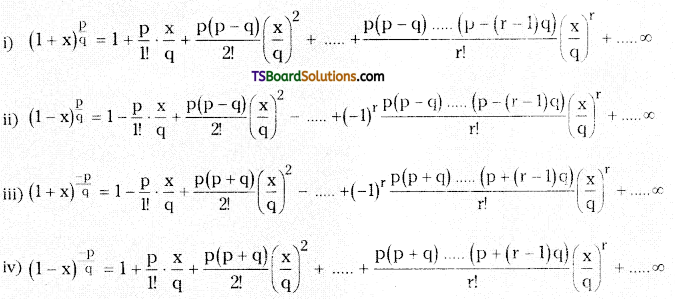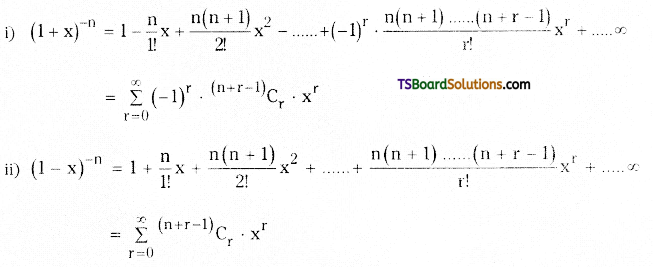Students must practice these Maths 2A Important Questions TS Inter Second Year Maths 2A Theory of Equations Important Questions Long Answer Type to help strengthen their preparations for exams.
TS Inter Second Year Maths 2A Theory of Equations Important Questions Long Answer Type
Question 1.
If the roots of the equation x3 + 3px2 + 3qx + r = 0 are in AP then show that 2p3 – 3pq + r = 0. [May ’08]
Solution:
Given equation is x3 + 3px2 + 3qx + r = 0
Since the roots are in A.P then they must be of the form a – d, a, a + d.
Now, s1 = a – d + a + a + d = \(\frac{-3 p}{1}\)
3a = – 3p
a = – p
Since a is a root of x3 + 3px2 + 3qx + r = 0 then
(- p)3 + 3p (- p)2 + 3q(- p) + r = 0
⇒ – p3 + 3p3 – 3pq + r = 0
⇒ 2p3 – 3pq + r = 0.
Question 2.
If the roots of the equation x3 + 3px2 + 3qx + r = 0 are in G.P then show that p3r = q3. [March ‘03]
Solution:
Given equation is x3 + 3px2 + 3qx + r = 0
Since the roots are in G.P then they must be of the form \(\frac{a}{r}\), a, ar
Now, s3 = \(\frac{a}{r}\) . a . ar
= \(\frac{-\mathrm{r}}{1}\) = – r
⇒ a3 = – r
⇒ a = (- r)1/3
Since a is a root of x3 + 3px2 + 3qx + r = 0 then
\(\left((-r)^{1 / 3}\right)^3+3 p\left((-r)^{1 / 3}\right)^2+3 q\left((-r)^{1 / 3}\right)\) + r = 0
⇒ – r + 3p (- r)2/3 + 3q(- r)1/3 + r = 0
⇒ 3p(- r)2/3 = – 3q(- r)1/3
Cubing on both sides,
⇒ p3 (- r)2 = – q3(- r)
⇒ p3 r2 = q3r
⇒ p3r = q3

Question 3.
If the roots of the equation x3 + 3px2 + 3q + r = 0 are in H.P then show that 2q3 = r (3pq – r).
Solution:
Given equation is x3 + 3px2 + 3qx + r = 0
The roots of x3 + 3px2 + 3qx + r = 0 are in H.P.
The roots of \(\left(\frac{1}{x}\right)^3+3 p\left(\frac{1}{x}\right)^2+3 q\left(\frac{1}{x}\right)\) + r = 0 are in A.p.
\(\frac{1}{x^3}+\frac{3 p}{x^2}+\frac{3 q}{x}\) + r = 0 are in A.P
⇒ 1 + 3px + 3qx2 + rx3 = o
⇒ rx3 + 3qx2 + 3px + 1 = 0 ……………..(1)
Let the roots of (1) be a – d, a, a + d
s1 = a – d + a + a + d = \(\frac{-3 q}{r}\)
⇒ 3a = \(\frac{-3 q}{r}\)
a = \(\frac{-q}{r}\)
Since a is a root of (1)
⇒ \(r \cdot \frac{-q^3}{r^3}+3 q \cdot \frac{q^2}{r^2}+3 p \cdot \frac{-q}{r}+1\) = 0
⇒ \(\frac{-q^3}{r^2}+\frac{3 q^3}{r^2}-\frac{3 p q}{r}\) + 1 = 0
⇒ 2q3 = r (3pq – r). +
Hence proved.
Question 4.
Solve 4x3 – 24x2 + 23x + 18 = 0, given that the roots of this equation are in arithmetic
progression. [Mar. ’14, May ’06, ’01]
Solution:
Given equation is 4x3 – 24x2 + 23x + 18 = 0
Given that the roots of this equation are in A.P.
Since the roots are in A.P, they must be of the form, a – d, a, a + d.
Now, a – d + a + a + d = \(-\frac{-24}{4}\) = 6
⇒ 3a = 6
⇒ a = 2
(a – d) a (a + d) = \(\frac{-18}{4}\)
(a2 – d2)a = \(\frac{-9}{2}\)
(4 – d2)2 = \(\frac{-9}{2}\)
4 – d2 = \(\frac{-9}{4}\)
d2 = 4 + \(\frac{9}{4}\) = \(\frac{25}{4}\)
d = ± \(\frac{5}{2}\)
Case – I:
If a = 2, d = \(\frac{5}{2}\)
The roots of given equation are – \(\frac{-1}{2}\), 2, \(\frac{9}{2}\).
Case-2:
If a = 2, d = \(\frac{-5}{2}\)
The roots of given equation are \(\frac{9}{2}\), 2, \(\frac{-1}{2}\).

Question 5.
Solve x3 – 3x2 – 6x + 8 = 0, given that the : roots are in A.P. [March ’07]
Solution:
Given equation is x3 – 3x2 – 6x + 8 = 0
Since, the roots are in A.P., thus they must; be of the form a – d, a, a + d.
Now, a – d + a + a + d = \(\frac{-(-3)}{1}\) = 3
⇒ 3a = 3
⇒ a = 1
⇒ (a – d) a (a + d) = \(\frac{-8}{1}\)
a2 – d2 = – 8
1 – d2 = – 8
d = 9
⇒ d = ±3
Case – 1 : If d = 3; a = 1
The roots of the given equation are; a – d, a, a + d = – 2, 1, 4.
Case – 2: If d = – 3; – a = 1;
The roots of the given equation are (a – d) a, (a + d) = 4, 1, – 2 .
Question 6.
Solve x3 – 7x2 + 14x – 8 = 0, given that the roots are in geometric progression. [May ’07]
Solution:
Given equation is x3 – 7x2 + 14x – 8 = 0
Given that the roots are in G.P then they may be of the form \(\frac{a}{r}\), a, ar
\(\frac{a}{r}\) + a + ar = a [\(\frac{1}{r}\) + 1 + r] = \(\frac{-(-7)}{1}\)
⇒ a[\(\frac{1}{r}\) + 1 + r] = 7 …………..(1)
\(\frac{a}{r}\) . a . ar = 1
⇒ a3 = 8
⇒ a = 2
(1) ⇒ 2\(\left(\frac{r^2+r+1}{r}\right)\) = 7
⇒ 2r2 – 5r + 2 = 0
⇒ 2r2 – 4r – r + 2 = 0
⇒ 2r (r – 2) – 1 (r – 2) = 0
⇒ (2r – 1) (r – 2) = 0
⇒ r = \(\frac{1}{2}\) (or) r = 2
Case – 1:
If a = 2, r = \(\frac{1}{2}\)
The roots of given equation are \(\frac{a}{r}\), a, ar = 4, 2, 1
Case – 2 :
If a = 2, r = 2
The roots of given equation are \(\frac{a}{r}\), a, ar = 1, 2, 4.
Question 7.
Solve the equation 15x3 – 23x2 + 9x – 1 = 0, the roots being in H.P. [May ’02]
Solution:
Giveti equation is 15x3 – 23x2 + 9x – 1 = 0
The roots of 15x3 – 23x2 + 9x – 1 = 0 are in H.P
The roots of
\(15 \cdot \frac{1}{x^3}-23 \cdot \frac{1}{x^2}+9 \cdot \frac{1}{x}-1\) = 0 are in A.P.
15 – 23x + 9x2 – x3 = 0
⇒ x3 – 9x2 + 23x – 15 = 0
Let the roots be a – d, a, a + d
a – d + a + a + d = \(\frac{-(-9)}{1}\) = 9
⇒ 3a = 9
⇒ a = 3
(a – d) a (a + d) = \(\frac{-(-15)}{1}\) = 15
⇒ a(a2 – d2) = 15
⇒ 3(9 – d2) = 15
9 – d2 = 5
d2 = 4
d = 21
The roots of x3 – 9x2 + 23x – 15 = 0 are a – d, a, a + d =3 – 2, 3, 3 + 2 = 1, 3, 5
The roots of 15x3 – 23x2 + 9x – 1 = 0 are \(\frac{1}{1}, \frac{1}{3}, \frac{1}{5}\) = 1, \(\frac{1}{3}, \frac{1}{5}\).

Question 8.
Solve 18x3 + 81x2 + 121x + 60 = 0 given that one root is equal to half the sum of the remaining roots. [May ’11, March ‘05] [AP – Mar.2019]
Solution:
Given that one root is equal to half of the sum of the remaining roots.
Given equation is 18x3 + 81x2 + 121x + 60 = 0
i.e., the roots are in A.P.
Let a – d, a, a + d be the roots of the given equation.
∴ a – d + a + a + d = \(\frac{-81}{18}\)
3a = \(\frac{-81}{18}\)
a = \(\frac{-3}{2}\)
(a – d) a (a + d) = \(\frac{-60}{18}\)
a(a – d) = \(\frac{-81}{18}\)
\(\frac{-3}{2}\left(\frac{9}{4}-d^2\right)=\frac{-60}{18}\)
d2 = \(\frac{9}{4}-\frac{20}{9}=\frac{81-80}{36}=\frac{1}{36}\)
d = \(\frac{1}{6}\)
∴ The roots of the given equation are a – d, a, a + d = \(\frac{-3}{2}-\frac{1}{6}, \frac{-3}{2}, \frac{-3}{2}+\frac{1}{6}\)
= \(\frac{-5}{3}, \frac{-3}{2}, \frac{-4}{3}\)
Question 9.
Given that one root of 2x3 + 3x2 – 8x + 3 = 0 is double the other root, find the roots of the equation. [May ’03]
Solution:
Given equation is 2x3 + 3x2 – 8x + 3 = 0
Now, α + β + γ = \(\frac{-3}{2}\) …………..(1)
αβ + βγ + γα = \(\frac{-8}{2}\) = – 4 ……………(2)
αβγ = \(\frac{-3}{2}\) ……………..(3)
Given one root is double the other then
α = 2β
(1) ⇒ 2β + β + γ = \(\frac{-3}{2}\)
⇒ 3β + γ = \(\frac{-3}{2}\)
⇒ γ = \(\frac{-3}{2}\) – 3β …………….(4)
(2) ⇒ 2β . β + βγ + γ . 2β = – 4
2β2 + βγ + 2βγ = – 4
2β2 + 3βγ = – 4 ……………..(5)
From (4) & (5)
2β2 + 3β(\(\frac{-3}{2}\) – 3β) = – 4
2β2 – \(\frac{9 \beta}{2}\) – 9β2=
⇒ \(\frac{4 \beta^2-9 \beta-18 \beta^2}{2}\) = – 4
⇒ – 14β2 – 9β = – 8
⇒ 14β2 + 9β – 8 = 0
⇒ 14β2 + 16β – 7β – 8 = 0
⇒ (2β – 1) (7β + 8) = 0
⇒ β = \(\frac{-8}{7}\) (or) β = \(\frac{1}{2}\)
β = \(\frac{-8}{7}\) does not satisfy the given equation.
β = \(\frac{1}{2}\)
⇒ α = 2 . \(\frac{1}{2}\) = 1
Substitute the value of β in equation (4)
⇒ γ = \(\frac{-3}{2}\) – 3 . \(\frac{1}{2}\)
= \(\frac{-3-3}{2}=\frac{-6}{2}\) = – 3.
∴ The roots of the given equation are 1, \(\frac{1}{2}\), – 3.

Question 10.
Solve x4 + x3 – 16x2 – 4x + 48 = 0, given that the product of two of the roots is 6. [TS – Mar. 2019; May ’12. ’09]
Solution:
Given equation is x4 + x3 – 16x2 – 4x + 48 = 0
Let α, β, γ, δ are the roots of the given equation.
Then αβγδ = \(\frac{48}{1}\) = 48
Given that the product of the two roots of the given equation is 6.
Suppose that αβ = 6
Now, 6γδ = 48
γδ = 8
Let α + β = p, γ + δ = q
The quadratic equation whose roots are α, β is
x2 – x(α + β) + αβ = 0
x2 – px + 6 = 0 ………….(1)
The quadratic equation whose roots are γ, δ is
x2 – x (γ + δ) + γδ = 0
⇒ x2 – qx + 8 = 0 ……………(2)
∴ x4 + x3 – 16x2 – 4x + 48
= (x2 – px + 6) (x2 – qx + 8)
= x4 – qx3 + 8x2 – px3 + pqx2 – 8px + 6x2 – 6qx + 48
= x4 + (- p – q)x3 + (pq+ 14)x2 + (- 8p – 6q) x + 48
Now comparing coefficients of x3 on both sides, we get
⇒ – p – q = 1
⇒ p + q = – 1 ………………(3)
Now comparing coefficients of x on both sides, we get
– 8p – 6q = – 4
⇒ 4p + 3q = 2 ……………….(4)
Solve (3) and (4);
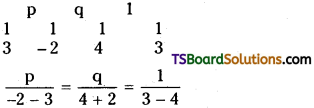
⇒ p = \(\frac{-5}{-1}\)
⇒ q = \(\frac{6}{-1}\)
⇒ p = 5, q = – 6
Substitute ‘p’ value in (1),
x2 – 5x + 6 = 0
⇒ x2 – 3x – 2x + 6 = 0
⇒ x (x – 3) – 2 (x – 3) = 0
⇒ (x – 2) (x – 3) = 0
⇒ x = 2, x = 3
Substitute ‘q’ value in (2),
(2) ⇒ x2 + 6x + 8 = 0
⇒ x2 + 4x . 2x + 8 = 0
⇒ (x + 2) (x +4) = 0
⇒ x = – 4, x = – 2
∴ The roots of given equation are 3, 2, – 4, – 2.
Question 11.
Given that two roots of 4×3+20×2-23x+6=O are equal, find all the roots of the given equation.
Solution:
Given equation is 4x3 + 20x2 – 23x + 6 = 0
Let α, β, γ be the roots of given equation.
Then s1 = α + β + γ = \(\frac{-(20)}{4}\)
⇒ α + β + γ = – 5 …………….(1)
⇒ αβ + βγ + γα = \(\frac{-23}{4}\) ……………(2)
⇒ αβγ = \(\frac{-6}{4}=\frac{-3}{2}\) ………….(3)
Given that two roots are equal
⇒ β = α
(1) ⇒ 2α + γ = – 5
⇒ γ = – 5 – 2α
(2) ⇒ α2 + αy + αy = \(\frac{-23}{4}\)
⇒ α2 + 2αγ = \(\frac{-23}{4}\)
⇒ α2 + α (- 5 – 2α) = \(\frac{-23}{4}\)
⇒ 4 (α2 – 10α – 4α2) = – 23
⇒ 4 (- 3α2 – 10α) = – 23
⇒ 12α2 + 40α – 23 = 0
⇒ 12α2 + 46α – 6α – 23 = 0
⇒ 2α (6α + 23) – 1(6α + 23) = 0
⇒ (6α + 23) (2α – 1) = 0
∴ α = \(\frac{-23}{6}\) does not satisfy given equation.
∴ α = \(\frac{1}{2}\)
⇒ β = \(\frac{1}{2}\)
γ = – 5 – 2 . \(\frac{1}{2}\) = – 6
γ = – 6
∴ The roots of the given equation are \(\frac{1}{2}\), \(\frac{1}{2}\), – 6.

Question 12.
Solve x4 + 4x3 – 2x2 – 12x + 9 = 0, given that it has two pairs of equal roots. [March ’11, ’03]
Solution:
Given equation is x4 + 4x3 – 2x2 – 12x + 9 = 0
Given that it has two pairs of equal roots then let the roots of the given equation be
α + α + β + β = \(\frac{-4}{1}\)
⇒ 2 (α + β) = – 4
⇒ α + β = – 2
αα + αβ + βα + βα + αβ + β2 = \(\frac{-2}{1}\)
α2 + 4αβ + β2
(α + β)2 + 2αβ = – 2
4 + 2αβ = – 2
2αβ = – 6
αβ = – 3
We know that,
(α – β)2 = (α + β)2 – 4αβ
= 4 – 4 (- 3)
= 4 + 12 = 16
α – β = 4
α + β = – 2
⇒ 2α = 2
⇒ α = 1
α + β = – 2
1 + β = – 2
β = – 3
∴ The roots of the given equation are 1, 1, – 3, – 3.
Question 13.
Find the roots of x4 – 16x3 + 86x2 – 176x + 105 = 0. [March ’08, ’02]
Solution:
Let f(x) = x4 – 16x3 + 86x2 – 176x + 105 = 0
If x = 1 then f(1)= 1 – 16 + 86 – 176 + 105 = 0
= 192 – 192 = 0
Hence, 1 is a root of f(x) = 0
If x = 3 then
f(3) = 81 – 16 (27) + 86(9) – 176(3) + 105
= 81 – 432+ 774 – 528 + 105
= 960 – 960 = 0
Hence 3 is a root of f(x) = 0.
By the method of synthetic division we have

∴ The quotient is x2 – 12x + 35 and remainder is zero.
∴ f(x) = x4 – 16x3 + 86x2 – 176x + 105
= (x – 1)(x – 3) (x2 – 12x + 35)
= (x – 1) (x – 3) (x – 5) (x – 7)
Hence the roots of the given equation are 1, 3, 5, 7.
Question 14.
Solve x4 – 10x3 + 26x2 – 10x + 1 = 0. [TS – Mar. ‘18; Mar. ‘12, ’10, Board Paper]
Solution:
Given equation is x – 10x3 + 26x2 – 10x + 1 = O
This is standard form of reciprocal equation.
The given equation is a reciprocal degree of class – 1 on dividing with x2
⇒ x2 – 10x + 26 – \(\frac{10}{x}+\frac{1}{x^2}\) = 0
\(\left(x^2+\frac{1}{x^2}\right)-10\left(x+\frac{1}{x}\right)\) + 26 = 0
If x + \(\frac{1}{x}\) = a
⇒ x2 + \(\frac{1}{x^2}\) = a2 – 2
⇒ (a2 – 2) – 10a + 26 = 0
⇒ a2 – 10a + 24 = 0
⇒ a2 – 6a – 4a + 24 = 0
⇒ a (a – 6) – 4 (a – 6) = 0
If (a – 4) (a – 6) = 0
⇒ a = 4, a = 6
If a = 4
⇒ x + \(\frac{1}{x}\) = 4
⇒ x2 – 4x + 1 = 0
⇒ x = \(\frac{-(-4) \pm \sqrt{16-4(1)}}{2(1)}\)
= \(\frac{4 \pm \sqrt{12}}{2}\)
= 2 ± √3
If a = 6 x + \(\frac{1}{x}\) = 4
⇒ x2 – 6x + 1 = 0
x = \(\frac{-(-6) \pm \sqrt{36-4(1)(1)}}{2(1)}=\frac{6 \pm \sqrt{32}}{2}\)
= 3 ± 2√2
Hence ti roots of the given equation are 2 ± √3, 3 ± 2√2.

Question 15.
Solve the quation 6x4 – 35x3 + 62x2 – 35x + 6 = 0. [May ’13, ’10]
Solution:
Given equation is 6x4 – 35x3 + 62x2 – 35x + 6 = 0
This is a standard form of reciprocal equation.
The given equation is an even degree reciprocal equation of class – 1
On dividing both sides of given equation by x2, we get
6x2 – 35x + 62 – \(\frac{35}{x}+\frac{6}{x^2}\) = 0
\(6\left(x^2+\frac{1}{x^2}\right)-35\left(x+\frac{1}{x}\right)\) + 62 = 0
Let x + \(\frac{1}{x}\) = a
⇒ \(\mathrm{x}^2+\frac{1}{\mathrm{x}^2}\) = a2 – 2
⇒ 6(a2 – 2) – 35a + 62 = 0
⇒ 6a2 – 12 – 35a + 62 = 0
⇒ 6a2 – 35a + 50 = 0
⇒ 6a2 – 15a – 20a + 50 = 0
⇒ 3a (2a – 5) – 10 (2a – 5) = 0
⇒ (2a – 5)(3a – 10) = 0
⇒ 2a = 5; 3a = 10
a = \(\frac{5}{2}\) a = \(\frac{10}{3}\)
If a = \(\frac{5}{2}\)
⇒ x + \(\frac{1}{x}\) = \(\frac{5}{2}\)
⇒ 2x2 + 2 = 5x
⇒ 2x2 – 5x + 2 = 0
⇒ 2x2 – 4x – x + 2 = 0
⇒ 2x (x – 2) – 1 (x – 2) = 0
⇒ x = \(\frac{1}{2}\) (or) x = 2
If a = \(\frac{10}{3}\)
⇒ x + \(\frac{1}{x}\) = \(\frac{10}{3}\)
⇒ 3x2 + 3 = 10x
⇒ 3x2 – 10x + 3 = 0
⇒ 3x2 – 9x – x + 3 = 0
⇒ 3x (x – 3) – 1 (x – 3) = 0
x = \(\frac{1}{3}\) (or) x = 3
∴ The roots are 2, 3, \(\frac{1}{2}\), \(\frac{1}{3}\).
Question 16.
Solve 2x5 + x4 – 12x3 – 12x2 + x + 2 = 0. [TS – May ‘15: AP-Mar. ’17, ‘16; March ‘08, ‘07]
Solution:
Given equation is 2x5 + x4 – 12x3 – 12x2 + x + 2 = 0
Let f(x) = 2x5 + x4 – 12x3 – 12x2 + x + 2 = 0
If x = – 1
⇒ (- 1) = 2 (- 1) + 1 – 12 (- 1) – 12(1) + (- 1) + 2
= – 2 + 1 + 12 – 12 – 1 + 2 = 0
∴ (x + 1) is a factor of f(x).
On dividing f(x) by (x + 1) we get,

∴ 2x4 – x3 – 11x2 – x + 2 = 0
On dividing with x2 on both sides, we get
⇒ 2x2 – x – 11 – \(\frac{1}{x}+\frac{2}{x^2}\) = 0
⇒ \(2\left(x^2+\frac{1}{x^2}\right)-1\left(x+\frac{1}{x}\right)\) – 11 = 0
Let x + \(\frac{1}{x}\) = a
⇒ x2 + \(\frac{1}{x^2}\) + 2 = a2
⇒ x2 + \(\frac{1}{x^2}\) = a2 – 2
⇒ 2(a2 – 2) – 1 (a) – 11 = 0
⇒ 2a2 – 4 – a – 11 = 0
⇒ 2a2 – a – 15 = 0
⇒ 2a2 – 6a + 5a – 15 = 0
⇒ 2a (a – 3) + 5 (a – 3) = 0
⇒ (a – 3) (2a + 5) = 0
a = 3; a = – \(\frac{5}{2}\)
If a = 3;
x + \(\frac{1}{x}\) = 3
x2 – 3x + 1 = 0
x = \(\frac{-(-3) \pm \sqrt{9-4}}{2(1)}=\frac{3 \pm \sqrt{5}}{2}\)
If a = – \(\frac{5}{2}\)
x + \(\frac{1}{x}\) = – \(\frac{5}{2}\)
⇒ 2x2 + 5x + 2 = 0
⇒ 2x2 + 4x + x + 2 = 0
⇒ 2x (x + 2) + 1 (x + 2) = 0
⇒ (2x + 1) (x + 2) = 0
∴ x = – \(\frac{1}{2}\), x = – 2
∴ The roots are – 1, – \(\frac{1}{2}\), – 2, \(\frac{3 \pm \sqrt{5}}{2}\).

Question 17.
Solve the equation x5 – 5x4 + 9x3 – 9x2 + 5x – 1 = 0. [AP – May 2016; March ‘13]
Solution:
Given equation is x5 – 5x4 + 9x3 – 9x2 + 5x – 1 = 0
Let f(x) = x5 – 5x4 + 9x3 – 9x2 + 5x – 1
If x = 1
f(1)= 15 – 5(1)4 + 9(1)3 – 9(1)2 + 5(1) – 1
= 1 – 5 + 9 – 9 + 5 – 1 = 0
∴ (x – 1) is a factor of 1(x).
On dividing x5 – 5x3 + 9x3 – 9x2 + 5x – 1 by x – 1

∴ x4 – 4x3 + 5x2 – 4x + 1 = 0
This is a standard form of reciprocal equation.
Now, on dividing with x2 on both sides, we get
x2 – 4x + 5 – \(\frac{4}{x}+\frac{1}{x^2}\) = 0
\(\left(x^2+\frac{1}{x^2}\right)\) – 4 \(\left(x+\frac{1}{x}\right)\) + 5 = 0
Let x + \(\frac{1}{x}\) = a
⇒ [x + \(\frac{1}{x}\)]2 = a2
⇒ x2 + \(\frac{1}{x^2}\) + 2 = a2
⇒ x2 + \(\frac{1}{x^2}\) = a2 – 2
⇒ a2 – 2 – 4a + 5 = 0
⇒ a2 – 4a + 3 = 0
⇒ a2 – 3a – a + 3 = 0
⇒ a (a – 3) – 1 (a – 3) = 0
⇒ (a – 1) (a – 3) = 0
⇒ a = 1 (or) a = 3
If a = 1
⇒ x + \(\frac{1}{x}\) = 1
⇒ x2 – x + 1 = 0
⇒ x = \(\frac{-(-1) \pm \sqrt{1-4}}{2(1)}=\frac{1 \pm \mathrm{i} \sqrt{3}}{2}\)
If a = 3
⇒ x + \(\frac{1}{x}\) = 3
⇒ x2 – 3x + 1 = 0
⇒ x = \(\frac{-(-3) \pm \sqrt{9-4}}{2(1)}=\frac{3 \pm \sqrt{5}}{2}\)
∴ The roots are 1, \(\frac{1 \pm \mathrm{i} \sqrt{3}}{2}\), \(\frac{3 \pm \sqrt{5}}{2}\).
Question 18.
Solve the equation 6x6 – 25x5 + 31x4 – 31x2 + 25x – 6 = 0. [AP – Mar. ‘18. May 2015]
Solution:
Given equation is 6x6 – 25x5 + 31x4 – 31x2 + 25x – 6 = 0
The given equation is an even degree reciprocal equation of class – 2.
Let f(x) = 6x6 – 25x5 + 31x4 – 31x2 + 25x – 6 = 0
If x = 1 then f(1) = 6 – 25 + 31 – 31 + 25 – 6 = 0
∴ (x – 1) is a factor of f(x).
If x = – 1 then
f(- 1) = 6 + 25 + 31 – 31 – 25 – 6 = 0
∴ (x + 1) is a factor of f(x).
On dividing 1(x) by x + 1 and x – 1 we get,

∴ Quotient is 6x4 – 25x3 + 37x2 – 25x + 6
6x4 – 25x3 + 37x2 – 25x + 6 = 0
This is standard form of reciprocal equation.
This is an even degree reciprocal equation of class – 1.
On dividing both sides with x2.
6x2 – 25x + 37 – \(\frac{25}{x}+\frac{6}{x^2}\) = 0
\(6\left(x^2+\frac{1}{x^2}\right)-25\left(x+\frac{1}{x}\right)\) + 37 = 0
Let x + \(\frac{1}{x}\) = a
\(x^2+\frac{1}{x^2}\) = a2 – 2
⇒ 6(a2 – 2) – 25a + 37 = 0
⇒ 6a2 – 25a + 25 = 0
⇒ 6a2 – 15a – 10a + 25 = 0
⇒ 3a(2a – 5) – 5 (2a – 5) = 0
⇒ (3a -5) (2a – 5) = 0
⇒ a = \(\frac{5}{2}\), a = \(\frac{5}{3}\)
If a = \(\frac{5{2}\)
⇒ x + \(\frac{1}{x}\) = a
⇒ x + \(\frac{1}{x}\) = \(\frac{5}{2}\)
⇒ 2x2 – 5x + 2 = 0
⇒ 2x2 – 4x – x + 2 = 0
⇒ 2x (x – 2) – 1 (x – 2) = 0
⇒ x = \(\frac{1}{2}\); x = 2
If a = \(\frac{5}{3}\)
⇒ x + \(\frac{1}{x}\) = \(\frac{5}{3}\)
⇒ 3x2 – 5x + 3 = 0
x = \(\frac{-(-5) \pm \sqrt{25-4(3)(3)}}{2(3)}\)
= \(\frac{5 \pm \sqrt{25-36}}{6}=\frac{5 \pm \mathrm{i} \sqrt{11}}{6}\)
∴ The roots are ± 1, 2, \(\frac{1}{2}\), \(\frac{5 \pm \mathrm{i} \sqrt{11}}{6}\).

Question 19.
Find the polynomial equation of degree 5 whose roots are the translates of the roots of x5 + 4x3 – x2 + 11 = 0 by – 3. [March ’06]
Solution:
Let f(x) = x5 + 4x3 – x2 + 11 = 0
∴ The required equation is f(x + 3) = 0
∴ f(x + 3) = A0x5 + A1x4 + A2x3 + A3x2 + A4x + A5
The coefficients A0, A1, A2, A3, A4, A5 can be obtained as follows
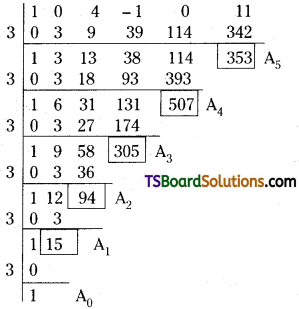
∴ Required equation is f(x + 3) = 0
x5 + 15x4 + 94x3 + 305x2 + 507x + 353 = 0
Question 20.
Solve the equation x4 – 9x3 + 27x2 – 29x + 6 = 0 given that one root is 2 – √3. [May ’03]
Solution:
Given equation is x4 – 9x3 + 27x2 – 29x + 6 = 0
2 – √3 is a root of it then 2 + √3 is also root.
The quadratic factor of these two roots is (x – (2 + √3)) (x – (2 – √3))
= (x – (2 – √3)) (x – (2 + √3))
= ((x – 2) – √3) ((x – 2) + √3)
= (x – 2)2 – (√3)2
= x2 – 4x + 4 – 3
= x2 – 4x + 1
On dividing x4 – 9x3 + 27x2 – 29x + 6 with x2 – 4x + 1

∴ Quotient is x2 – 5x + 6 = 0
∴ x2 – 5x + 6 = 0
⇒ x2 – 3x – 2x + 6 = 0
⇒ x(x – 3) – 2 (x – 3) = 0
⇒ (x – 2) (x – 3) = 0
⇒ x = 2 (or) x = 3
∴ The roots of given equation are 2, 3, 2 ± √3.
Question 21.
Show that x5 – 5x3 + 5x2 – 1 = 0, has three equal roots and find that root. [TS – Mar. 2017]
Solution:
Given equation is x5 – 5x3 + 5x2 – 1 = 0
Let f(x) = x5 – 5x3 + 5x2 – 1
f'(x) = 5x4 – 15x2 + 10x
f”(x) = 20x3 – 30x + 10
f(1) = 20 – 30 + 10 = 0
Similarly f'(1) = 0 and f(1) = 0
∴ (x – 1) is a factor of f”(x), f'(x) and f(x).
Thus f(x) = 0 has three equal roots and it is 1.

Question 22.
Find the condition that x3 – px2 + qx – r = 0 may have the roots in G.P.
Solution:
q3 = p3r.
Question 23.
Solve 8x3 – 36x2 – 18x + 81 = 0, given that the roots are in AP. [March ‘04]
Solution:
\(\frac{-3}{2}, \frac{3}{2}, \frac{9}{2}\).
Question 24.
Solve 3x3 – 26x2 + 52x – 24 = 0, given that the roots are in A.P.
Solution:
\(\frac{2}{3}\), 2, 6
Question 25.
Solve the equation 6x3 – 11x2 + 6x – 1 = 0, the roots being in H.P.
Solution:
1, \(\frac{1}{2}\), \(\frac{1}{3}\)
Question 26.
Solve x3 – 7x2 + 36 = 0, gi0ven one root being twice the other.
Solution:
3, 6, – 2.

Question 27.
Solve x4 – 5x3 + 5x2 + 5x – 6 = 0, given that the product of two of its roots ¡s 3.
Solution:
2, – 1, 3, 1
Question 28.
Solve 9x3 – 15x2 + 7x – 1 = 0, given that two of its roots are equal.
Solution:
\(\frac{1}{3}\), \(\frac{1}{3}\), 1.
Question 29.
Solve x3 – 3x2 – 10x + 48 = 0.
Solution:
3, – 4, 4.
Question 30.
Solve the equation 4x3 – 13x2 – 13x + 4 = 0.
Solution:
– 1, \(\frac{1}{4}\), – 4
Question 31.
Find the polynomial equation whose roots are the translates of those of the equation. [TS – Mar. ’16]
x5 – 4x4 + 3x2 – 4x + 6 = Oby – 3.
Solution:
x5 + 11x4 + 42x3 – 57x2 – 13x – 60 = 0
Question 32.
Solve the equation x4 + 2x3 – 16x2 – 22x + 7 = 0 given that 2 – √3 is one of its roots.
Solution:
2 ± √3, – 3 ± √2.

Some More Maths 2A Theory of Equations Important Questioons
Question 1.
Form the monic polynomial equation of degree 3 whose roots are 2, 3 and 6. [March ‘02]
Solution:
Let α = 2, β = 3, γ = 6
The monk equation having roots α, β, γ is
(x – α) (x – β) (x – γ) = 0
⇒ (x – 2) (x – 3) (x – 6) = 0
⇒ (x – 2) (x2 – 9x + 18) =0
⇒ x3 – 9x2 + 18x – 2x2 + 18x – 36 = 0
⇒ x3 – 11x2 + 36x – 36 = 0.
Question 2.
Form the monic polynomial equation of degree 4 whose roots are 4 + √3, 4 – √3, 2 + i and 2 – i.
Solution:
Let α = 4 + √3, β = 4 – √3, γ = 2 + i, δ = 2 – i
The equation whose roots are α, β, γ, δ is
(x – α) (x – β) (x – γ) (x – δ) = 0
(x – (4 + √3)) (x – (4 – √3))
(x – (2 + i)) (x – (2 – i)) = 0
((x – 4) – √3) ((x – 4) + √3)
((x – 2) – i) ((x – 2) + i) = 0
((x – 4)2 – 3) ((x – 2)2 – 2) = 0
(x2 + 16 – 8x – 3) (x2 + 4 – 4x + 1) = 0
(x2 – 8x + 13) (x2 – 4x + 5) = 0
x4 – 12x3 + 50x2 – 92x + 65 = 0
Question 3.
Find s1, s2, s3 and s4 for the equation 8×4 – 2×3 – 27×2 – 6x + 9=0.
Solution:
Given equation is 8x4 – 2x3 – 27x2 – 6x + 9 = 0
Comparing this equation with ax4 + bx3 + cx2 + dx + e = 0
a = 8; b = – 2; c = – 27; d = – 6; e = 0
Now,
s1 = \(\frac{-b}{a}=\frac{-(-2)}{8}=\frac{1}{4}\)
s2 = \(\frac{c}{a}=\frac{-27}{8}\)
s3 = \(\frac{-\mathrm{d}}{\mathrm{a}}=\frac{-(-6)}{8}=\frac{3}{4}\)
s4 = \(\frac{\mathrm{e}}{\mathrm{a}}=\frac{9}{8}\)

Question 4.
Find the algebraic equation whose roots are 3 times the roots of x3 + 2x2 – 4x + 1 = 0.
Solution:
Let f(x) = x3 + 2x2 – 4x + 1 = 0
∴ Required equation is f(\(\frac{x}{3}\)) = 0
\(\) = 0
⇒x3 + 6×2-36x + 27=0.
Question 5.
Find an algebraic equation of degree 4 whose roots are 3 times the roots of the equation 6x4 – 7x3 + 8x2 – 7x + 2 = 0.
Solution:
Let f(x) = 6x4 – 7x3 + 8x2 – 7x + 2 = 0
The required equation is f(\(\frac{x}{3}\)) = 0
\(\frac{6 x^4}{81}-\frac{7 x^3}{27}+\frac{8 x^2}{9}-\frac{7 x}{3}+2\) = 0
6x4 – 21x3 + 72x2 – 189x + 162 = 0
Question 6.
Find the transfonned equation whose roots are the negatives of the roots of x4 + 5x3 + 11x + 3 = 0.
Solution:
Let f(x) = x4 + 5x3 + 11x + 3 = 0
Required equation ¡s f(- x) = 0
⇒ (- x)4 + 5(- x)3 + 11(- x) + 3 = 0
⇒ x4 – 5x3 – 11x + 3 = 0
Question 7.
Find the polynomial equation of degree 4 whose roots are the negatives of the roots of x4 – 6x3 + 7x2 – 2x + 1 = 0.
Solution:
Let f(x) = x4 – 6x3 + 7x2 – 2x + 1 = 0
The required equation is f(- x) = 0
⇒ (- x)4 – 6(- x)3 + 7(- x)2 – 2(- x) + 1 = 0
⇒ x4 + 6x3 + 7x2 + 2x + 1 = 0.

Question 8.
Find the polynomial equation whose roots are the reciprocals of the roots of x5 + 11x4 + x3 + 4x2 – 13x + 6 = 0
Solution:
Let f(x) = x5 + 11x4 + x3 + 4x2 – 13x + 6 = 0
The required equation is f(\(\frac{1}{x}\)) = o
⇒ \(\frac{1}{x^5}+\frac{11}{x^4}+\frac{1}{x^3}+\frac{4}{x^2}-\frac{13}{x}+6\) + 6 = 0
⇒ 1 + 11x + x2 + 4x3 – 13x4 + 6x5 = 0
⇒ 6x5 – 13x4 + 4x3 + x2 + 11x + 1 = 0
Question 9.
Find the polynomial equation whose roots are the reciprocals of the roots of the equation x4 + 3x3 – 6x2 + 2x – 4 = 0.
Solution:
Let f(x) = x4 + 3x3 – 6x2 + 2x – 4 = 0
The required equation is f(\(\frac{1}{x}\))) = 0
⇒ \(\frac{1}{x^4}+\frac{3}{x^3}-\frac{6}{x^2}+\frac{2}{x}-4\) = 0
⇒ 4x4 – 2x3 + 6x2 – 3x – 1 = 0
Question 10.
Find the polynomial equation whose roots are the squares of the roots of x4 + x3 + 2x2 + x + 1 = 0.
Solution:
Let f(x) = x4 + x3 + 2x2 + x + 1 = 0
The required equation is f(√x) = 0
(√x)4 + (√x)3 + 2(√x)2 + √x + 1 = 0
x2 + x√x + 2x + √x + 1 = 0
x2 + 2x + 1 = – x(√x) – √x
= – √x (x + 1)
⇒ squaring on both sides
(x2 + 2x + 1)2 = (- √x (x + 1))2
⇒ x4 + 4x2 + 1 + 4x3 + 4x + 2x2 = x(x2 + 1 + 2x) = x3 + x + 2x2
x4 + 3x3 + 4x2 + 3x + 1 = 0.

Question 11.
Find the polynomial equation whose roots are the squares of the roots of x3 – x2 + 8x – 6 = 0.
Solution:
Let f(x) = x3 – x2 + 8x – 6 = 0
∴ The required equation is f(√x) = o
(√x)3 – (√x)2 + 8√x + 6 = 0
⇒ x√x – x + 8√x – 6 = 0
⇒ x + 6 = √x (x + 8)
⇒ squaring on both sides
⇒x2 + 36 + 12x = x(x2 + 64 + 16x)
⇒ x3 + 64x + 16x2
⇒ x3 + 15x2 + 52x – 36 = 0.
Question 12.
Find the condition that x3 – px2 + qx – r = 0 may have the roots in G.P.
Solution:
Given equation is x3 – px2 + qx – r = 0
Since the roots are in G.P. then they must be the of the form \(\frac{a}{r}\), a, ar.
Now s3 = \(\frac{a}{r}\) . a . ar
= \(\frac{-(-r)}{1}\)
a3 = r
a = r1/3
Since ‘a’ is a root of x3 – px2 + qx – r = 0
(r1/3)3 – p(r1/3)2 + q(r1/3) . r = 0.
⇒ r – pr2/3 + qr1/3 – r = 0
⇒ pr2/3 = qr1/3
Cubing on both sides.
⇒ p3r2 = q3r
⇒ p3r = q3
Question 13.
Solve 8x3 – 36x2 – 18x + 81 = 0, given that the roots are in AP.
Solution;
Given equation is 8x3 – 36x2 – 18x + 81 = 0
Since, the roots are in A.P, they must be of the form a – d, a, a + d.
Now, a – d + a + a + d = \(\frac{-(-36)}{8}\)
⇒ 3a = \(\frac{9}{2}\)
⇒ a = \(\frac{3}{2}\)
(a – d) a (a + d) = \(\frac{-81}{8}\)
(a2 – d2) a = \(\frac{-81}{8}\)
\(\frac{3}{2}\left(\frac{9}{4}-\mathrm{d}^2\right)=\frac{-81}{8}\)
\(\frac{9}{4}-d^2=\frac{-27}{4}\)
d2 = 36
⇒ d = ± 3.
Case – I:
a = \(\frac{3}{2}\), d = 3
The roots of the given equation are a – d, a, a + d
\(\frac{-3}{2}, \frac{3}{2}, \frac{9}{2}\)
Case – II: a = \(\frac{3}{2}\), d = – 3
The roots of the given equation are a – d, a, a + d
\(\frac{9}{2}, \frac{3}{2}, \frac{-3}{2}\)

Question 14.
Solve 3x3 – 26x2 + 52x – 24 = 0 the given, the roots are in Geometric Progression.
Solution:
Given equation is 3x3 – 26x2 + 52x – 24 = 0
Since the roots are in G.P they must be of the form \(\frac{a}{r}\), a, ar.
Now, \(\frac{a}{r}\) + a + ar = \(\frac{-(-26)}{3}\)
a(\(\frac{1}{r}\) + 1 + r) = \(\frac{26}{3}\) …………..(1)
\(\frac{a}{r}\) . a . ar = \(\frac{-(-24)}{3}\)
a3 = 8
a = 2
From (1)
⇒ \(2\left(\frac{1+r+r^2}{r}\right)=\frac{26}{3}\)
⇒ 3(r2 + r + 1) = 13r
⇒ 3r2 – 10r + 3 = 0
⇒ 3r2 – 9r – r + 3 = 0
⇒ 3r (r – 3) – 1(r – 3) = 0
⇒ (r – 3) (3r – 1) = 0
r = 3 (or) r = \(\frac{1}{3}\)
Case – 1:
a = 2, r = 3
The roots of the given equation are \(\frac{a}{r}\), a, ar = \(\frac{2}{3}\), 2, 6
Case – II:
a = 2, r = \(\frac{1}{3}\)
The roots of the given equation are \(\frac{a}{r}\), a, ar = 6, 2, \(\frac{2}{3}\).
Question 15.
Solve the equation 6x3 – 11x2 + 6x – 1 = 0, the roots being in 1-LP.
Solution:
Given equation is 6x3 – 11x2 + 6x – 1 = 0
The roots of 6x3 – 11x2 + 6x – 1 = 0 are in H.P
The roots of \(6 \cdot \frac{1}{x^3}-11 \cdot \frac{1}{x^2}+\frac{6}{x}-1\) = 0 are in A.P.
6 – 11x + 6x2 – x3 = 0
x3 – 6x2 + 11x – 6 = 0
Let the roots be a – d, a, a + d
a – d + a + a + d = \(\frac{-(-6)}{1}\)
3a = 6
a = 2
(a – d) a (a + d) = \(\frac{-(-6)}{1}\) = 6
⇒ 2(a2 – d2) = 6
⇒ 4 – d2 = 3
⇒ d2 = 1
⇒ d = 1
The roots of x3 – 6x2 + 11x – 6 = 0 are a – d, a, a + d = 1, 2, 3.
∴ The roots of 6x3 – 11x2 + 6x – 1 = 0 are 1, \(\frac{1}{2}\), \(\frac{1}{3}\).
Question 16.
Solve x3 – 7x2 + 36 = 0, given one root being twice the other.
Solution;
Given equation is x’ – 7×2 + 36 = 0
Let α, β, γ be the roots of the given equation.
Now, α + β + γ = \(\frac{-(-7)}{1}\)
⇒ α + β + γ = 7 …………..(1)
αβ + βγ + γα = \(\frac{0}{1}\) = 0
⇒ αβ + βγ + γα = 0 ………….(2)
αβγ = \(\frac{-36}{1}\) = – 36
⇒ αβγ = – 36 ……………(3)
Given that one root being twke the other then β = 2α
(1) ⇒ α + 2α + γ = 7
⇒ 3α + γ = 7
⇒ α = 7 – 3α
(2) ⇒ α . 2α + 2αγ + αγ = 0
⇒ 2α + 3αγ = o
⇒ 2α2 + 3α (7 – 3α) = 0
⇒ 2α2 + 21α – 9α2 = 0
⇒ 7α2 – 21α = 0
⇒ α2 – 3α =0
⇒ α (α – 3) = 0
⇒ α = 0 (or) α = 3
α = 0 does not satisfy the given equation.
∴ α = 3
If α =3
⇒ β = 6
γ = 7 – 3α
= 7 – 3 . 3
= 7 – 9
⇒ γ = – 2
∴ The roots of the given equation are 3, 6, – 2.

Question 17.
Solve x4 – 5x3 + 5x2 + 5x – 6 = 0, given that the product of two of its roots is 3.
Solution:
Let α, β, γ, δ are the roots of given equation.
⇒ αβγδ = – 6
Given that the product of two roots is 3
αβ = 3
⇒ 3γδ = – 6
⇒ γδ = – 2
Let α + β = p, γ + δ = q
The quadratic equation whose roots are α, β is
x2 – x(α + β) + αβ = 0
⇒ x2 – px + 3 = 0 …………….(1)
The quadratic equation ol roots γ, δ is
x2 – x(γ + δ) + γδ = 0
⇒ x2 – qx – 2 = 0 ………………(2)
∴ x4 – 5x3 + 5x2 + 5x – 6 = (x2 – px + 3) (x2 – qx – 2)
= x4 – qx3 – 2x2 – px3 + pqx2 + 2px + 3x2 – 3qx – 6
= x4 + x 3 (- p – q) + x2 (1 + pq) + x (2p – 3q) – 6
x3coeff. ⇒ – p – q = – 5
⇒ p + q = 5 ……………..(3)
xcoeff. ⇒ 2p – 3q = 5 …………..(4)
Solving (3) and (4)

p = 4, q = 1
Sub. p = 4 in (1)
⇒ x2 -4x + 3 = 0
⇒ x2 – 3x – x + 3 = 0
⇒ x (x – 3) – 1 (x – 3) = 0
⇒ (x – 1) (x – 3) = 0
⇒ x – 1 = 0 (or) x – 3 = 0
⇒ x = 1 (or) x = 3
Sub.q = 1 in (2)
⇒ x2 – x – 2 = 0
⇒ x2 – 2x + x – 2 = 0
⇒ x (x – 2) + 1 (x – 2) = 0
⇒ (x + 1) (x – 2) = 0
⇒ x = 2 (or) x = – 1
The roots of given equation are – 1, 1, 2, 3.
Question 18.
Solve 9x3 – 15x2 + 7x – 1 = 0, given that two of its roots are equal.
Solution:
Given equation is 9x3 – 15x2 + 7x – 1 = 0
Let α, β, γ are the roots of 9x – 15x2 + 7x – 1 = 0
Now, α + β + γ = \(\frac{-(-15)}{9}=\frac{5}{3}\) ⇒ 1
⇒ αβ + βγ + γα = \(\frac{7}{9}\) …………….(2)
αβγ = \(\frac{-(-1)}{9}=\frac{1}{9}\) …………(3)
Given α = β; (1)
⇒ 2α + γ = \(\frac{5}{3}\) ……………(4)
(2) ⇒ α2 + αγ + γα = \(\frac{7}{9}\)
α2 + 2αγ = \(\frac{7}{9}\)
γ = \(\frac{7}{18 \alpha}-\frac{\alpha}{2}\) ………….(5)
From (4) 2α + \(\frac{7}{18 \alpha}-\frac{\alpha}{2}=\frac{5}{3}\)
⇒ \(\frac{36 \alpha^2+7-9 \alpha^2}{18 \alpha}=\frac{5}{3}\)
⇒ 27α2 – 30α + 7 = 0
⇒ 27α2 – 21α – 9α + 7 = 0
⇒ 3α (9α – 7) – 1 (9α – 7) = 0
⇒ (3α – 1) (9α – 7) = 0
∴ α = \(\frac{1}{3}\), β = \(\frac{7}{9}\)
α = does not satisfy the given equation.
∴ α = \(\frac{1}{3}\), β = \(\frac{1}{3}\)
(4) ⇒ \(\frac{2}{3}\) + γ = \(\frac{5}{3}\)
γ = \(\frac{5}{3}-\frac{2}{3}=\frac{3}{3}\) = 1
γ = 1
∴ The roots of the given equation are \(\frac{1}{3}\), \(\frac{1}{3}\), 1.

Question 19.
Solve x3 – 3x2 – 16x + 48 = 0.
Solution:
Let f(x) = x3 – 3x2 – 16x + 48 = 0
If x = 3
⇒ f(3) = 27 – 27 – 48 + 48 = 0
Hence 3 is a root of f(x) = 0.
Now, we divide f(x) by x – 3 using synthetic division

∴ The quotient is x2 – 16 and the remainder is zero.
∴ f(x) = x3 – 3x2 – 16x + 48
= (x – 3) (x2 – 16)
= (x – 3) (x + 4) (x – 4)
∴ The roots are 3, – 4, 4.
Question 20.
Solve the equation 4x3 – 13x2 – 13x + 4 = 0.
Solution:
Given equation is 4x3 – 13x2 – 13x 4 = 0.
f(x) = 4x3 – 13x2 – 13x + 4
If x = – 1
⇒ f(- 1) = 4(- 1)3 – 13(- 1)2 – 13(- 1) + 4
= – 4 – 13 + 13 + 4 = 0
∴ (x + 1) is a factor of f(x).
Now, on dividing 4x3 – 13x2 – 13x + 4 = 0 by x + 1.

Quotient is 4x2 – 17x + 4
4x2 – 17x + 4 = 0
4x2 – 16x – x + 4 = 0
=4x (x – 4) – 1 (x – 4) = 0
(4x – 1) (x – 4) = 0
x = \(\frac{1}{4}\), x = 4
∴ 4x3 – 13x2 – 13x + 4 = (x + 1) (x – 4) (4x – 1)
∴ The roots of the given equation are – 1, 4, 1/4.
Question 21.
Find the polynomial equation whose roots are the translates of those of the equatior x5 – 4x4 + 3x2 – 4x + 6 = 0 by – 3.
Solution:
Let f(x) = x5 – 4x4 + 3x2 – 4x + 6
∴ The required equation is f(x + 3) =0
∴ f(x+3) = A0x5 + A1x4 + A2x3 + A3x2 + A4x + A5
The coefficients A0, A1, A2, A3, A4, A5 can be obtained as follows.
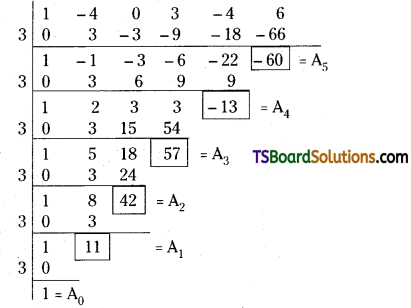
∴ Required equation ¡s f(x + 3) = 0
x5 + 11x4 + 42x3 + 57x2 – 13x – 60 = 0.

Question 22.
Solve the equation x4 + 2x3 – 16x2 – 22x + 7 = 0 given that 2 – √3 is one of its roots.
Solution:
Given equation is x4 + 2x3 – 16x2 – 22x + 7 = 0 ……………..(1)
Let f(x) = x4 + 2x3 – 16x2 – 22x + 7
Given 2 – √3 is a root of (1).
⇒ 2 + √3 is also a root of (1).
(∵ coefficients of (1) are rational)
∴ (x – (2 – √3)) (x – (2 + √3)) is a factor of f(x).
(x2 – 4x + 1)is a factor of f(x).
We divide f(x) by x2 – 4x 1.
By synthetic division,

∴ f(x)=(x2 – 4x +1 ) (x2 + 6x + 7)
∴ Equation (1)
z(x2 – 4x + 1) (x2 + 6x + 7) = 0
=x2 – 4x + 1 = 0 or x2 + 6x + 7 = 0
x = 2 ± √3 or x = – 3 ± √2
∴ The roots of the given equation are 2 ± √3, – 3 ± √2.
Question 23.
If α, β, γ are the roots of x3 + px2 + qx + r = 0, then form the monic cubic equation whose roots are α(β + γ), β(γ + α), γ(α + β).
Solution:
Given equation is x3 + px2 + qx + r = 0
Since α, β, γ are the roots of the equation.
x3 + px2 + qx + r = 0 then
s1 = α + β + γ = \(\frac{-p}{1}\) = – p;
s2 = αβ + βγ + γα = \(\frac{q}{1}\) = q;
s3 = αβγ = \(\frac{-r}{1}\) = – r
Let s1 = Σ α(β + γ)
= Σ (αβ + αγ) = Σ αβ + Σ αγ = Σ αβ + Σ αβ = 2Σ αβ = 2q
s2 = Σ α(β + γ) . β(γ + α)
= Σ αβ (- p – α) (- p – β)
= Σ αβ (p + α) (p + β)
= Σ αp (p2 + p(α + β) + αβ)
= Σ αp [p2 + p(- p – γ) + ap]
= Σ αβ [p2 – p2 – pγ + αβ]
= – pΣ αβγ + Σ αβ
= – p(3αβγ) + (αβ + βγ + γα)2 – 2αβγ(α + β + γ)
= – 3p (- r) + q2 – 2 (- r) (- p)
= 3pr + q2 – 2pr
= q2 + pr
s3 = α (β + γ) β (γ + α) γ (α + β)
= αβγ(- p – α) (- p – β) (- p – γ)
= – αβγ [(p + α) (p + β) (p + γ)]
= – αβγ [(p2 + pα + pβ + αβ) (p + γ)]
= – αβγ [p3 + p2α + p2β + pαβ + p2γ + pαγ + pβγ + αβγ]
= – αβγ [p3 + p2 (α + β + γ) + p(αβ + βγ + γα) + αβγ]
= – (- γ)[p3 + p2 (- p) + p(q) + (- r)]
= γ [p3 – p3 + pq – r]
= pqr – r2
∴ The monic cubic equation whose roots are α (β + γ), β(γ + α), γ(α + β) is
x3 – s1x2 + s2x – s3 = 0
x3 – 2qx2 + (q2 + pr) x – r (pq – r) = 0.

Question 24.
If α, β, γ are the roots of x3 – 6x2 + 11x – 6 = 0, then find the equation whose roots are α2 + β2, β2 + γ2, γ2 + α2.
Solution:
Let f(x) = x3 – 6x2 + 11x – 6
If x = 1 then f(1) = 1 – 6 + 11 – 6 = 12 – 12 = 0
(x – 1) is the factor of f(x)

x2 – 5x + 6 = 0
⇒ x2 – 3x – 2x + 6 = 0
⇒ x (x – 3) – 2 (x – 3) = 0
⇒ (x – 2) (x – 3) = 0
⇒ x – 2 = 0; x – 3 = 0
Therefore, x3 – 6x2 + 11x – 6 = 0
⇒ (x – 1) (x – 2) (x – 3) = 0
⇒ x = 1, 2, 3
Since α, β, γ are the roots of x3 – 11x2 + 11x – 6 = 0
Then, α = 1; β = 2; γ = 3.
Now, α2 + β2 = 1 + 4 = 5;
β2 + γ2 = 4 + 9 = 13;
γ2 + α2 = 9 + 1 = 10
The equation having roots 5, 13, 10 is (x – 5) (x – 13) (x – 10) = 0
= (x2 – 18x + 65) (x – 10) = 0
x3 – 18x2 + 65x – 10x2 + 180x – 650 = 0
x3 – 28x2 + 245x – 650 = 0
Question 25.
If α, β, γ are the roots of x3 – 7x + 6 = 0, then find the equation whose roots are (α – β)2, (β + γ)2, (γ + α)2.
Solution:
Let f(x) = x3 – 7x + 6
If x = 1 then f(1) = 1 – 7(1) + 6 – 7 – 7 = 0
∴ (x – 1) is a factor of f(x)
x2 + x – 6 = 0
⇒ x2 + 3x – 2x – 6 = 0

x (x + 3) – 2 (x + 3) = 0
(x + 3) (x – 2) = 0
∴ x3 – 7x + 6 = 0
⇒ (x + 3) (x – 1) (x – 2) = 0
⇒ x = – 3, 1, 2
Since α, β, γ are the roots of x3 – 7x + 6 = 0
then, α = – 3; β = 1; γ = 2.
Now, (α – β)2 = (- 3 – 1)2 = 16;
(β – γ)2 = (1 – 2)2 = 1;
(γ – α)2 = (4 + 9)2 = 25
The equation having roots 16, 1, 25 is (x – 16) (x – 1) (x – 25) = 0
(x2 – 1 7x + 16) (x2 – 25) = 0
x3 – 17x2 + 16x – 25x2 + 465x – 400 = 0
x3 – 42x2 + 441x – 400 = 0.

Question 26.
Solve x3 – 9x2 + 14x + 24 = 0 given that two of the roots are in the ratIo 3: 2.
Solution:
Let the roots be 3α, 2α, β
3α + 2α + β = \(\frac{-(-9)}{1}\) = 9
⇒ 5α + β = 9
⇒ β = 9 – 5α ……………..(1)
3α . 2α + 2αβ + 3αβ = \(\frac{14}{1}\)
⇒ 6α2 + 5αβ = 14
6α2 + 5α – 14 = 0
⇒ 6α2 + 5α (9 – 5α)-14 =0
6α2 + 45α – 25α – 14 = 0
⇒ 19α2 + 45α – 14 = 0
⇒ 19α2 – 45α + 14 = 0
⇒ 19α2 – 38α – 7α + 14 = 0
⇒ 19α(α – 2) – 7(α – 2) = 0
(α – 2) (19α – 7) = 0
α = 2 (or)
α = \(\frac{7}{19}\)
⇒ α = \(\frac{14}{19}\)
⇒ 2α = does not satisfy the given equation.
∴ α = 2
3α = 6
2α = 4
(1) ⇒ β = 9 – 5(2)
(2) ⇒ 9 – 10 = – 1
β = – 1
∴ The roots of the given equation are 6, 4,- 1.
Question 27.
Solve the equation x4 – 6x3 + 13x2 – 24x + 36 = 0 given that they have multiple roots.
Solution:
Let f(x) = x4 – 6x3 + 13x2 – 24x + 36 = 0
if x = 3 then 81 – 6(27) + 13(9) – 24 (3) + 36
= 81 – 162 + 117 – 72 + 36
= – 234 + 234 = 0
∴ x = 3 is a root of f(x) = 0
Let g(x) = x3 – 3x2 + 4x – 12 = 0
If x = 3 then g(3) = 33 – 3(32) + 4(3) – 12
= 27 – 27 + 12 – 12 = 0
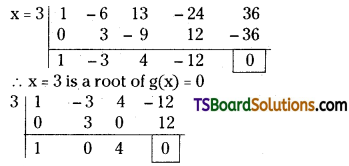
Let, h(x) = x2 + 4 = 0
⇒ x2 = – 4
x = ± √4 = ± 2
The roots of the given equation are 3, 3, ± 2i.
Multiple root is 3.

Question 28.
Solve the equation 8x3 – 20x2 + 6x + 9 = 0 given that the equation has multiple roots.
Solution:
Given equation is 8x3 – 20x2 + 6x + 9 = 0 ………………(1)
Let f(x) = 8x3 – 20x2 + 6x + 9
f’(x) = 24x2 – 40x + 6
= 2(12x2 – 20x + 3)
= 2 (2x – 3) (6x – 1)
\(f\left(\frac{3}{2}\right)=8\left(\frac{27}{8}\right)-20\left(\frac{9}{4}\right)+6\left(\frac{3}{2}\right)+9\)
= 27 – 45 + 9 + 9 = 0
∴ f(\(\left(\frac{3}{2}\right)\)) = 0
∴ f(x) and f’(x) has a common factor ‘2x – 3’.
∴ \(\frac{3}{2}\) is a multiple root of f(x) = 0.
By synthetic division,

∴ 8x3 – 20x2 + 6x + 9 = 0
=(x – \(\frac{3}{2}\))2 (8x + 4) = 0
x = \(\frac{3}{2}\) or x = \(\frac{-1}{2}\)
∴ The roots of given equation are \(-\frac{1}{2}, \frac{3}{2}, \frac{3}{2}\).
Question 29.
Solve 6x4 – 13x3 – 35x2 – x + 3 = 0, given that one of its roots is 2 + √3.
Solution:
Given equation is 6x4 – 13x3 – 35x2 – x + 3 = 0
Since 2 + √3 is a root of it, 2 – √3 is also a root.
The quadratic factor of these two roots is (x – (2 + √3)) (x – (2 – √3))
= ((x – 2) – √3) ((x – 2) + √3)
= (x – 2)2 – 3
= x2 + 4 – 4x – 3
= x2 – 4x + 1
On dividing, 6x4 – 13x3 – 35x2 – x + 3 by x2 – 4x + 1.

∴ Quotent is 6x2 + 11x + 3
6x2 + 11x + 3 = 0
6x2 + 9x + 2x + 3 = 0
3x (2x + 3) + 1 (2x + 3) = 0
= (3x + 1) (2x + 3) = 0
x = \(\frac{-1}{3}\), x = \(\frac{-1}{2}\)
∴ The roots of the given equation are \(\frac{-1}{2}\), \(\frac{-1}{2}\), 2 ± √3.

Question 30.
Solve the equation x4 + 2x3 – 5x2 + 6x + 2 = 0 given that 1 + i is one of its roots.
Solution:
Given equation is x4 + 2x3 – 5x2 + 6x + 2 = 0
Since 1 + i is a root of the given equation
then 1 – i is also a root of it.
The quadratic factor to these two roots is
(x – (1 + i)) ((x – (1 – i)) = 0
((x – 1) – i) ((x – 1) + i) = (x – 1) – i
x2 + 1 – 2x + 1 = x4 – 2x + 2
On dividing x4 + 2x3 – 5x2 6x + 2 by x2 – 2x + 2

Quotient is x2 + 4x + 1
x2 + 4x + 1 = 0
x = \(\frac{-4 \pm \sqrt{1-4}}{2(1)}\) = – 2 ± √3
∴ The roots of the given equation are 1 + i, 1 – i, – 2 ± √3.
Question 31.
Solve x4 – 4x2 + 8x + 35 = 0, given that 2 + √3 is a root. [AP – Mar. 2015]
Solution:
Given equation is x4 – 4x2 + 8x + 35 = 0
Since 2 + i√3 is a root of it,
2 – i√3 is also a root.
The quadratic factor to these two roots is (x – (2 + i√3)) (x – (2 – i√3))
= ((x – 2) – i√3) ((x – 2) + i√3)
= (x – 2)2 (i√3)2
= x2 + 4 – 4x + 3
= x2 – 4x + 1
On dividing x4 – 4x2 + 8x + 35 with x2 – 4x + 7 we get,

∴ Quotient is x2 + 4x + 5
x2 + 4x + 5 = 0
x = \(\frac{-4 \pm \sqrt{16-20}}{2(1)}=\frac{-4 \pm \sqrt{-4}}{2}\) = – 2
∴ The roots of the given equation are 2 ± i√3, – 2 ± i.

Question 32.
Solve the equation x4 – 6x3 + 11x2 – 10x + 2 = 0, given that 2 + √3 is a root of the equation.
Solution:
Given equation is x4 – 6x3 + 11x2 – 10x + 2 = 0
Since 2 + √3 is a root of it, 2 – √3 is also a root.
The quadratic factor to these roots is (x – (2 + √3)) (x – (2 – √3))
= ((x – 2) – √3) ((x – 2) + √3)
= (x – 2)2 – 3
= x2 + 4 – 4x – 3
= x2 – 4x + 1

∴ Quotient is x2 – 2x + 2
∴ x2 – 2x + 2 = 0
x = \(\frac{-(-2) \pm \sqrt{4-4(2)}}{2(1)}\)
= \(\frac{2 \pm 2 \mathrm{i}}{2}\) = 1 ± i.
∴ Roots of given equation are 2 ± √3, 1 ± i.
Question 33.
Find the polynomial equation whose roots are the translates of those of the equation x4 – 5x3 + 7x2 – 17x + 11 = 0 by – 2. [TS – May 2016]
Solution:
Let f(x) = x4 – 5x3 + 7x2 – 17x + 11 = 0
∴ The required equation is f(x + 2) = 0
Now, f(x + 2) = A0x4 + A1x3 + A2x2 + A3x + A4
Then, the coefficients A0, A1, A2, A3, A4 can
be obtained as follows

∴ Required equation is f(x + 2) = 0
x4 + 3x3 + x2 – 17x – 19 = 0.

Question 34.
Find the polynomial equation whose roots are the translates of the roots of the equation x4 – x3 – 10x2 + 4x + 24 = 0 by 2.
Solution:
Let f(x) = x4 – x3 – 10x2 + 4x + 24 = 0
∴ Required equation is f(x -2) = 0
Let f(x – 2) = A0x4 + A1x3 + A2x2 + A3x + A4.
The coefficients A0, A1, A2, A3, A4 can be obtained as follows
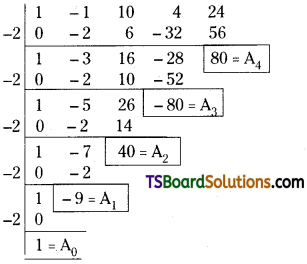
∴ Required equation is f(x – 2) = 0
x4 – 9x3 + 40x2 – 80x + 80 = 0.
![]()






















